What do bed bugs look like?
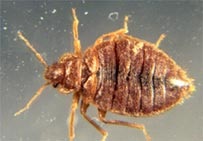
What do bed bugs look like?
Adult bed bugs are small, but visible to the naked eye. An adult bed bug is from 1/4 - 3/8 inches long and reddish brown. Bed bugs have an oval shape with a flattened body when unfed; their body becomes swollen after they have fed. The young nymph (immature) that has just hatched from the egg is less than 1/10 inches long and nearly colorless, but it becomes red after taking a blood meal. There are five nymphal stages, with each stage slightly larger than the preceding one. Nymphs typically are yellowish brown to reddish brown.
Bed bugs cannot fly, but they can walk very fast. They are able to cling tightly to surfaces, and they can fit into very small cracks and crevices where they often hide during the day.
Adult bed bugs are small, but visible to the naked eye. An adult bed bug is from 1/4 - 3/8 inches long and reddish brown. Bed bugs have an oval shape with a flattened body when unfed; their body becomes swollen after they have fed. The young nymph (immature) that has just hatched from the egg is less than 1/10 inches long and nearly colorless, but it becomes red after taking a blood meal. There are five nymphal stages, with each stage slightly larger than the preceding one. Nymphs typically are yellowish brown to reddish brown.
Bed bugs cannot fly, but they can walk very fast. They are able to cling tightly to surfaces, and they can fit into very small cracks and crevices where they often hide during the day.
How do bed bugs grow?
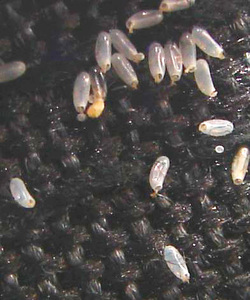
How do bed bugs grow and develop?
Bed bugs are parasitic insects. Human blood is their preferred food, but they will also feed on rodents, bats, birds and pets, if humans aren't available.During its life cycle, a bed bug hatches from an egg into a nymph and molts (sheds its old skin) five times before becoming a full sized adult, about the size of an apple seed. Eggs are glued onto a surface by the adult female bed bug. All nymphal stages and adults require blood meals. Bed bugs typically bite at night. However, they also can feed during the daytime.
Bed bugs are parasitic insects. Human blood is their preferred food, but they will also feed on rodents, bats, birds and pets, if humans aren't available.During its life cycle, a bed bug hatches from an egg into a nymph and molts (sheds its old skin) five times before becoming a full sized adult, about the size of an apple seed. Eggs are glued onto a surface by the adult female bed bug. All nymphal stages and adults require blood meals. Bed bugs typically bite at night. However, they also can feed during the daytime.
Where do bed bugs hide?
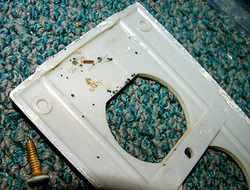
Where are bed bugs found/where do they hide?
Bed bugs can be found in places that are frequented or occupied by humans. Bed bugs are most commonly found in dwellings with a high rate of occupant turnover, such as hotels, hostels, dormitories, apartment complexes, movie theaters, and the like. Bed bugs also can infest private dwellings. Bed bugs can infest airplanes, ships, trains, and buses.
Bed bugs will hide in mattresses and box springs, bed frames, dressers, upholstered furniture and other furniture, cracks and crevices, electrical outlets, carpet tack strips, baseboards, window and door casings, drapery pleats, wall hangings, ceiling moldings, seams in wallpaper, etc. Bed bugs prefer to contact fabric, wood, and paper surfaces -- all of which are common in human dwellings
Bed bugs can be found in places that are frequented or occupied by humans. Bed bugs are most commonly found in dwellings with a high rate of occupant turnover, such as hotels, hostels, dormitories, apartment complexes, movie theaters, and the like. Bed bugs also can infest private dwellings. Bed bugs can infest airplanes, ships, trains, and buses.
Bed bugs will hide in mattresses and box springs, bed frames, dressers, upholstered furniture and other furniture, cracks and crevices, electrical outlets, carpet tack strips, baseboards, window and door casings, drapery pleats, wall hangings, ceiling moldings, seams in wallpaper, etc. Bed bugs prefer to contact fabric, wood, and paper surfaces -- all of which are common in human dwellings
Signs of Bed bugs
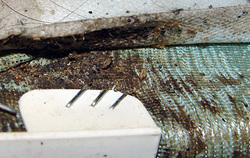
What are the tell-tale signs of bed bugs?
The most obvious signs of bed bugs are small black spots (feces) deposited in and
near bed bug hiding places. Shed bed bug skins, egg shells and live bed bugs also may be found. Another sign is blood stains, which typically occur when a bed bug is squashed. Itchy red welts may be the result of bed bug bites, but other insects, arthropods and medical conditions can produce similar reactions. It is important to confirm whether the bites were caused by bedbugs by conducting a bed bug inspection.
The most obvious signs of bed bugs are small black spots (feces) deposited in and
near bed bug hiding places. Shed bed bug skins, egg shells and live bed bugs also may be found. Another sign is blood stains, which typically occur when a bed bug is squashed. Itchy red welts may be the result of bed bug bites, but other insects, arthropods and medical conditions can produce similar reactions. It is important to confirm whether the bites were caused by bedbugs by conducting a bed bug inspection.
How to avoid or prevent bed bugs
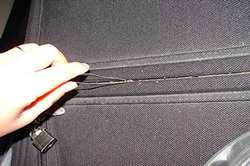
How do I avoid/prevent bed bugs?
You can encounter bed bugs almost anywhere including where you shop, work, go to school and vacation. Remember, an ounce of prevention is worth a pound of cure - so take a few simple steps to help prevent an infestation.
• Bed bugs can enter homes by latching onto your clothing, shoes and bags. Used furniture, luggage and backpacks are great hiding places for bugs as well. Bed bugs can also travel along connecting pipes and wiring from one room or apartment to another.
• Never bring bed frames, mattresses, box springs or upholstered furniture found on the street into your home. (No dumpster diving!)
• Check all used or rented furniture for bed bugs. For more info, check out thrift store tips
• When traveling, inspect the bed and furniture. Keep suitcases off the floor and bed, and inspect them before you leave. See travel tips
• If you suspect you have been around bed bugs, immediately wash your clothing on hot
settings and dry on the high heat setting for at least 30 minutes after the items are dry or store items in a sealed plastic bag until you can.
• Seal cracks and crevices with caulk, even if you don't have bed bugs. This will help prevent bed bugs and other pests from coming in.
You can encounter bed bugs almost anywhere including where you shop, work, go to school and vacation. Remember, an ounce of prevention is worth a pound of cure - so take a few simple steps to help prevent an infestation.
• Bed bugs can enter homes by latching onto your clothing, shoes and bags. Used furniture, luggage and backpacks are great hiding places for bugs as well. Bed bugs can also travel along connecting pipes and wiring from one room or apartment to another.
• Never bring bed frames, mattresses, box springs or upholstered furniture found on the street into your home. (No dumpster diving!)
• Check all used or rented furniture for bed bugs. For more info, check out thrift store tips
• When traveling, inspect the bed and furniture. Keep suitcases off the floor and bed, and inspect them before you leave. See travel tips
• If you suspect you have been around bed bugs, immediately wash your clothing on hot
settings and dry on the high heat setting for at least 30 minutes after the items are dry or store items in a sealed plastic bag until you can.
• Seal cracks and crevices with caulk, even if you don't have bed bugs. This will help prevent bed bugs and other pests from coming in.
Call Armor Pest Control at (513) 503-1483 for Bed Bug Answers
Serving the communities of Cincinnati, Fairfax, Mariemont, Hyde Park, Centerville, Lebanon, Middletown Ohio, Northern Kentucky, Monroe, Blue Ash, West Chester, Mason, Xenia, Beavercreek, West Carrollton, Newport KY, Liberty Township, Hamilton, Maineville, Morrow, Loveland, Anderson, Pierce Township, Butler County, Fairfield, Springboro, Franklin, Oxford, Milford, Batavia, Fairborn, Huber Heights, Lawrenceburg IN, Indian Hill, Dayton, Oxford, Amelia and Williamsburg.
